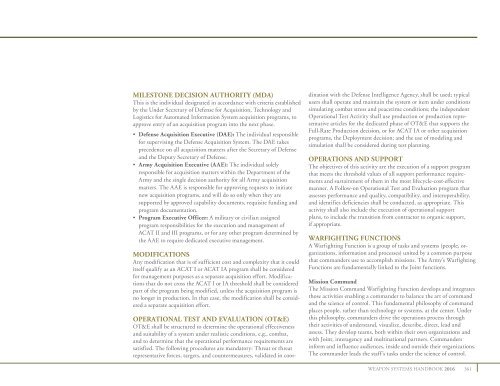AMERICA’S ARMY WINNING IN A COMPLEX WORLD
431298
431298
Create successful ePaper yourself
Turn your PDF publications into a flip-book with our unique Google optimized e-Paper software.
MILESTONE DECISION AUTHORITY (MDA)<br />
This is the individual designated in accordance with criteria established<br />
by the Under Secretary of Defense for Acquisition, Technology and<br />
Logistics for Automated Information System acquisition programs, to<br />
approve entry of an acquisition program into the next phase.<br />
• Defense Acquisition Executive (DAE): The individual responsible<br />
for supervising the Defense Acquisition System. The DAE takes<br />
precedence on all acquisition matters after the Secretary of Defense<br />
and the Deputy Secretary of Defense.<br />
• Army Acquisition Executive (AAE): The individual solely<br />
responsible for acquisition matters within the Department of the<br />
Army and the single decision authority for all Army acquisition<br />
matters. The AAE is responsible for approving requests to initiate<br />
new acquisition programs, and will do so only when they are<br />
supported by approved capability documents, requisite funding and<br />
program documentation.<br />
• Program Executive Officer: A military or civilian assigned<br />
program responsibilities for the execution and management of<br />
ACAT II and III programs, or for any other program determined by<br />
the AAE to require dedicated executive management.<br />
MODIFICATIONS<br />
Any modification that is of sufficient cost and complexity that it could<br />
itself qualify as an ACAT I or ACAT IA program shall be considered<br />
for management purposes as a separate acquisition effort. Modifications<br />
that do not cross the ACAT I or IA threshold shall be considered<br />
part of the program being modified, unless the acquisition program is<br />
no longer in production. In that case, the modification shall be considered<br />
a separate acquisition effort.<br />
OPERATIONAL TEST AND EVALUATION (OT&E)<br />
OT&E shall be structured to determine the operational effectiveness<br />
and suitability of a system under realistic conditions, e.g., combat,<br />
and to determine that the operational performance requirements are<br />
satisfied. The following procedures are mandatory: Threat or threat<br />
representative forces, targets, and countermeasures, validated in coordination<br />
with the Defense Intelligence Agency, shall be used; typical<br />
users shall operate and maintain the system or item under conditions<br />
simulating combat stress and peacetime conditions; the independent<br />
Operational Test Activity shall use production or production representative<br />
articles for the dedicated phase of OT&E that supports the<br />
Full-Rate Production decision, or for ACAT IA or other acquisition<br />
programs, the Deployment decision; and the use of modeling and<br />
simulation shall be considered during test planning.<br />
OPERATIONS AND SUPPORT<br />
The objectives of this activity are the execution of a support program<br />
that meets the threshold values of all support performance requirements<br />
and sustainment of them in the most lifecycle-cost-effective<br />
manner. A Follow-on Operational Test and Evaluation program that<br />
assesses performance and quality, compatibility, and interoperability,<br />
and identifies deficiencies shall be conducted, as appropriate. This<br />
activity shall also include the execution of operational support<br />
plans, to include the transition from contractor to organic support,<br />
if appropriate.<br />
WARFIGHT<strong>IN</strong>G FUNCTIONS<br />
A Warfighting Function is a group of tasks and systems (people, organizations,<br />
information and processes) united by a common purpose<br />
that commanders use to accomplish missions. The Army’s Warfighting<br />
Functions are fundamentally linked to the Joint functions.<br />
Mission Command<br />
The Mission Command Warfighting Function develops and integrates<br />
those activities enabling a commander to balance the art of command<br />
and the science of control. This fundamental philosophy of command<br />
places people, rather than technology or systems, at the center. Under<br />
this philosophy, commanders drive the operations process through<br />
their activities of understand, visualize, describe, direct, lead and<br />
assess. They develop teams, both within their own organizations and<br />
with Joint, interagency and multinational partners. Commanders<br />
inform and influence audiences, inside and outside their organizations.<br />
The commander leads the staff’s tasks under the science of control.<br />
WEAPON SYSTEMS HANDBOOK 2016 361


